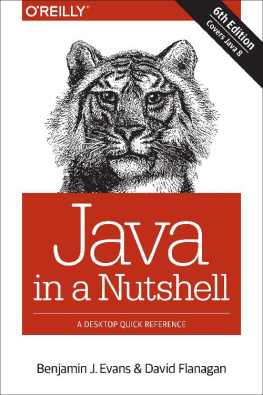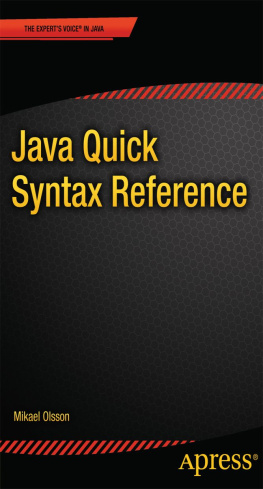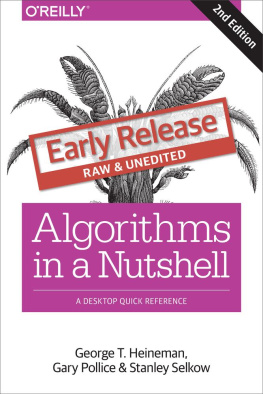Ben Evans - Java in a Nutshell - A Desktop Quick Reference.
Here you can read online Ben Evans - Java in a Nutshell - A Desktop Quick Reference. full text of the book (entire story) in english for free. Download pdf and epub, get meaning, cover and reviews about this ebook. year: 2019, genre: Computer. Description of the work, (preface) as well as reviews are available. Best literature library LitArk.com created for fans of good reading and offers a wide selection of genres:
Romance novel
Science fiction
Adventure
Detective
Science
History
Home and family
Prose
Art
Politics
Computer
Non-fiction
Religion
Business
Children
Humor
Choose a favorite category and find really read worthwhile books. Enjoy immersion in the world of imagination, feel the emotions of the characters or learn something new for yourself, make an fascinating discovery.
- Book:Java in a Nutshell - A Desktop Quick Reference.
- Author:
- Genre:
- Year:2019
- Rating:3 / 5
- Favourites:Add to favourites
- Your mark:
- 60
- 1
- 2
- 3
- 4
- 5
Java in a Nutshell - A Desktop Quick Reference.: summary, description and annotation
We offer to read an annotation, description, summary or preface (depends on what the author of the book "Java in a Nutshell - A Desktop Quick Reference." wrote himself). If you haven't found the necessary information about the book — write in the comments, we will try to find it.
Java in a Nutshell - A Desktop Quick Reference. — read online for free the complete book (whole text) full work
Below is the text of the book, divided by pages. System saving the place of the last page read, allows you to conveniently read the book "Java in a Nutshell - A Desktop Quick Reference." online for free, without having to search again every time where you left off. Put a bookmark, and you can go to the page where you finished reading at any time.
Font size:
Interval:
Bookmark:

by Ben Evans and David Flanagan
Copyright 2019 Benjamin J. Evans and David Flanagan. All rights reserved.
Printed in the United States of America.
Published by OReilly Media, Inc. , 1005 Gravenstein Highway North, Sebastopol, CA 95472.
OReilly books may be purchased for educational, business, or sales promotional use. Online editions are also available for most titles (.
- Editor: Virginia Wilson
- Production Editor: Justin Billing
- Copyeditor: Jasmine Kwityn
- Proofreader: Rachel Monaghan
- Indexer: WordCo Indexing Services, Inc.
- Interior Designer: David Futato
- Cover Designer: Karen Montgomery
- Illustrator: Rebecca Demarest
- December 2018: Seventh Edition
- 2018-11-30: First Release
See http://oreilly.com/catalog/errata.csp?isbn=9781492037255 for release details.
The OReilly logo is a registered trademark of OReilly Media, Inc. Java in a Nutshell, the cover image, and related trade dress are trademarks of OReilly Media, Inc.
The views expressed in this work are those of the authors, and do not represent the publishers views. While the publisher and the authors have used good faith efforts to ensure that the information and instructions contained in this work are accurate, the publisher and the authors disclaim all responsibility for errors or omissions, including without limitation responsibility for damages resulting from the use of or reliance on this work. Use of the information and instructions contained in this work is at your own risk. If any code samples or other technology this work contains or describes is subject to open source licenses or the intellectual property rights of others, it is your responsibility to ensure that your use thereof complies with such licenses and/or rights.
978-1-492-03725-5
[LSI]
This book is dedicated to all who teach peace and resist violence.
Java 8 was released in March 2014, and the 6th edition of Java in a Nutshell came out a few months later. In the intervening four and a half years, there have been a great many changes in the Java world. The biggest news has been the arrival of Javas platform modules (Project Jigsaw), and the change to a new six-month release cycle. These two developments are key to allowing the Java platform and ecosystem to continue to evolve and succeed for another 20 years.
The long-delayed Java 9 release (which introduced modules) has been followed by Java 10 and 11 in quick succession, with Java 8 and 11 being the current long-term supported releases. These changes in release cadence have brought the open source OpenJDK to the forefront of the Java world, as now virtually all Java releases are based upon, and licensed under, the open codebase.
With the continued development of the platform, it has adapted well to new frontiers (such as cloud and microservices) due to new features that have arrived in Java 9 to Java 11. The Java world seems well placed to continue to thrive in the coming years, whether developers are working with the trusty workhorse of Java 8 or joining the microservices world with Java 11.
In either case, this is a great time to be joining (or returning to) application development in Java. Looking forward, the future holds some major changes (such as value types) that will alter the character of Java development in fundamental ways. The next year or two will start to see these changes arrive and become part of the Java developers everyday experience.
Once again, in working on this new edition of Davids classic text, if I have preserved the feel of Java in a Nutshell, while updating it to bring it to the attention of a new generation of developers, then I shall be well satisfied.
Ben Evans, Monterey, 2018
This book is a desktop Java reference, designed to sit faithfully by your keyboard while you program. is a reference section that blends elucidation of core concepts with examples of important core APIs.The book covers Java 11, but we recognize that some shops may not haveadopted it yetso where possible we call out if a feature was introducedin Java 8, 9, or 10.We use Java 11 syntax throughout, including var and lambda expressions .
The sixth edition of this book covers Java 8, whereas this editioncovers Java 11.However, the release process of Java changed significantly with the advent of Java 9, so this book is released only a year after Java 9 arrived.Java 11 is also the first long-term support (LTS) release of Java since Java 8, so it seems likely that many Java shops will jump straight to Java 11 from Java 8.
With the seventh edition we have tried to update the concept of what it means to be a Nutshell guide.The modern Java developer needs to know more than just syntax and APIs.As the Java environment has matured, such topics as concurrency, object-oriented design, memory, and the Java type system have all grown inimportanceeven among mainstream developers.
In this edition, we have taken the approach that only the most recent versions of Java are likely to be of interest to the majority of Java developers, so we usually only call out when new features arrived if it was with Java 8 or later.
The module system (that arrived with Java 9) is still likely to be new for at least some developers, and it represents a major change.
The first six chapters document the Java language and theJava platformthey should all be considered essential reading. The bookis biased toward the Oracle/OpenJDK (Open Java Development Kit)implementation of Java, but not greatly so. Developers working with otherJava environments will still find plenty to occupy them. includes:
This chapter is an overview of the Java language and the Javaplatform. It explains the important features and benefits of Java,including the lifecycle of a Java program. We also touch on Javasecurity and answer some criticisms of Java.
This chapter explains the details of the Java programming language,including the Java 8 language changes. It is a long and detailedchapter that does not assume substantial programming experience.Experienced Java programmers can use it as a language reference.Programmers with substantial experience with languages such as C andC++ should be able to pick up Java syntax quickly by reading thischapter; beginning programmers with only a modest amount of experienceshould be able to learn Java programming by studying this chaptercarefully, although it is best read in conjunction with an introductory text(such as OReillys Head FirstJava by Bert Bates and Kathy Sierra).
This chapter describes how the basic Java syntax documented in is used to write simpleobject-oriented programs using classes and objects in Java. Thechapter assumes no prior experience with object-oriented programming. It can beused as a tutorial by new programmers or as a reference by experiencedJava programmers.
This chapter builds on the basic description of object-orientedprogramming in Java, and introduces the other aspects of Javas typesystem, such as generic types, enumerated types, and annotations. Withthis more complete picture, we can discuss the biggest change in Java8the arrival of lambda expressions.
This chapter is an overview of some basic techniques used in thedesign of sound object-oriented programs, and briefly touches on thetopic of design patterns and their use in software engineering.
Font size:
Interval:
Bookmark:
Similar books «Java in a Nutshell - A Desktop Quick Reference.»
Look at similar books to Java in a Nutshell - A Desktop Quick Reference.. We have selected literature similar in name and meaning in the hope of providing readers with more options to find new, interesting, not yet read works.
Discussion, reviews of the book Java in a Nutshell - A Desktop Quick Reference. and just readers' own opinions. Leave your comments, write what you think about the work, its meaning or the main characters. Specify what exactly you liked and what you didn't like, and why you think so.

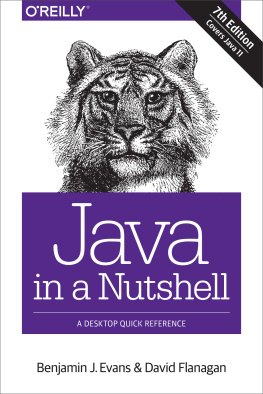



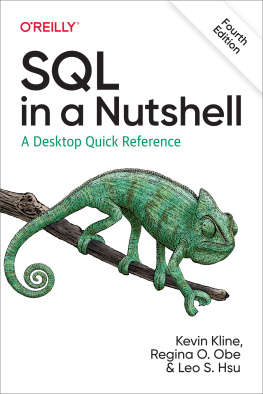

![Kline Kevin E. - SQL in a nutshell: [a desktop quick reference ; covers MySQL, Oracle, PostgreSQL, and SQL server]](/uploads/posts/book/138111/thumbs/kline-kevin-e-sql-in-a-nutshell-a-desktop.jpg)
